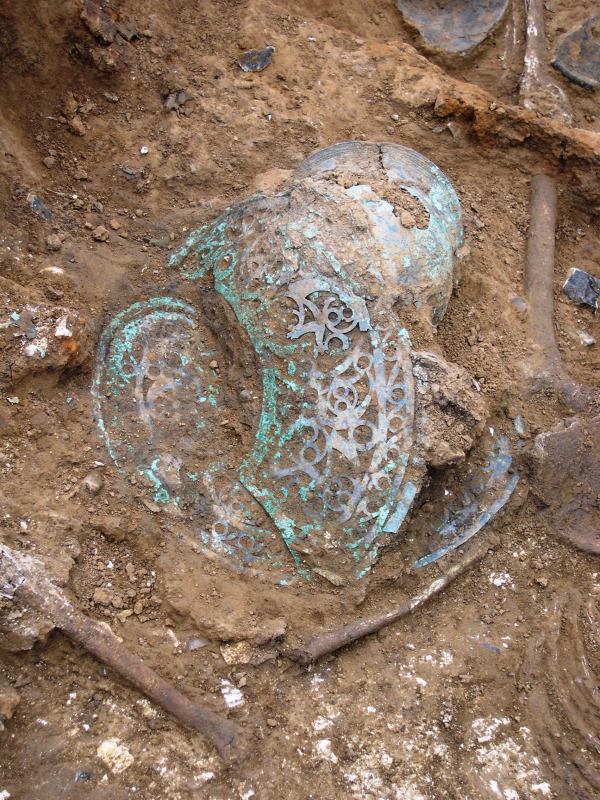The discovery of a 1400-year-old warrior buried in a British field is being hailed as a major discovery and is providing new insights into the so-called Dark Ages and early English history. Specifically, the burial may provide a better understanding of the origins of the Kingdom of Wessex , which played a crucial role in the development of what became England.
Anglo-Saxon Warrior Grave Had All The Signs Of Power
In 2018, two metal detectorists discovered two bronze bowls in a field, not far from Dorchester in southern England. Since then an archaeological mission from Reading University has been investigating the site. Recently, they uncovered the remains of an Anglo-Saxon warrior grave and a hoard of spectacular grave goods. The dead man in the Anglo-Saxon warrior grave was found with his sword still in its ornate scabbard, alongside spearheads and a knife. According to the Guardian the man in the Anglo-Saxon warrior grave is “known as the Marlow warrior.”

However, not all the experts agree that the dead man in the Anglo-Saxon warrior grave was a warrior. Many men in the Dark Ages wanted to be buried with weapons because of their symbolism. Dr Gabor Thomas, who participated in the dig, told the Independent that “Being macho at this period… it was a significant part of people’s lives.” There is evidence that shows that the deceased was indeed a warrior and a cut mark on his scabbard seems to indicate that he was involved in some kind of fighting.

The wealth of grave goods found in this near-perfect Anglo-Saxon warrior grave included imported beakers and bowls. The fact that he was not buried with other members of the community also indicates that he was a member of the elite.
The evidence strongly suggests that he may have been a leader of a war band. The orientation of his grave and the fact that it is located on a site with a sweeping view may indicate that “He is positioned deliberately to look over that territory,” Dr Thomas told the Guardian. This may indicate that he was a petty-king or a tribal chief. He was likely buried at the site in the late 6 th century AD.

The New Anglo-Saxon Warrior Grave And The Age Of King Arthur
The 6th century AD was a crucial period in British and, specifically, English history. It was a time when the legendary King Arthur is believed to have reigned. This was the era following the collapse of the Western Roman Empire when Anglo-Saxon invaders were competing with native Celtic groups for control of what is now England. Various war-bands fought each other and established often transitory states, some of which later became important kingdoms.
The dead man in the Anglo-Saxon warrior grave was a big strong man. He was about 6 feet (1.83 meters) tall, which was very tall for the time, and muscular. Thomas is quoted by the Express Informer as saying that he “would have been an imposing figure even today.” It is unlikely that he grew so muscular by simply training and fighting to be a warrior. It is also likely that he engaged in manual work.

The Power Of The Kingdom Of Wessex
The man in the recently discovered Anglo-Saxon warrior grave died in battle or from a terrible plague or illness. The researchers wrote that the burial was very unusual. Based on flints found at the site, the researchers believe that a rock cairn may have been built over the grave. The Independent reports that “the Marlow warrior’s shield was not buried with him, it is possible that it was placed on top of the cairn.”

Interestingly, the burial is not far from the probable “epicentre of the Kingdom of Wessex,” according to the Independent. The Kingdom of Wessex became the most powerful in southern England. During the Viking invasions of the 9 th century AD, the kingdom, under Alfred the Great, was able to unite the remaining Anglo-Saxon kingdoms. Wessex, which means the kingdom of the West Saxons, played a critical role in the evolution of England as a nation.

Trusted Warriors From Germany and Others Created Wessex
The discovery of the Anglo-Saxon warrior grave may help to shed light on the origins of the Kingdom of Wessex and the key role it played in the history of England. Previous DNA analysis indicated that local Celtic and even Irish warrior war-band leaders played were crucial in the founding and development of Wessex.
The Independent reports that originally Wessex “was known as the Kingdom of the Gewisse – a Germanic word meaning ‘the trusted ones’ or ‘those [warriors] who could be relied upon’.” The Kingdom of Gewisse was probably formed by Germanic mercenaries in the employ of local rulers after the departure of the Roman legions. And they may have fought with local Celtic and other warriors after the Romans left. Over time, after lengthy wars with the native Romano-Britons, they created a small political and military force that became the Kingdom of Wessex.





